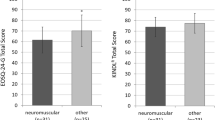Abstract
We studied the effects of spondylodesis on spinal curvature, functional outcome, level of ambulation and perceived competence in 11 children with osteogenesis imperfecta (OI). Mean age at surgical intervention was 13.1 years (SD 2.5 years) and follow-up amounted to 3.4 years (SD 2.3 years). Spinal curvature was measured according to Cobb. The level of ambulation was scored according to the modified criteria of Bleck. Functional abilities and the amount of parental assistance were scored using the Dutch version of the Pediatric Evaluation of Disability Inventory (PEDI). Perceived competence was measured using the Harter Self-Perception Profile for Children. The amount of fatigue, spinal pain and presence of subjective dyspnea were scored with a visual analog scale. The median progression per year before spondylodesis was 6.1° (interquartile range 2.9°–12.9°) and after the spondylodesis it was 5.0° (interquartile range 1.6°–11.0°). No significant progression or regression in the level of ambulation was found. Perceived competence improved slightly. In the total score of the perceived competence, a borderline significant increase was found (P-value 0.068). We concluded that spinal fusion in children with OI does not materially influence functional ability and level of ambulation. Self-perceived competence seemed to improve after surgery. The amount of pain, fatigue and subjective dyspnea seemed to diminish after spinal surgery. Progression of scoliosis proceeded, as did development of spinal curvature at the junction of the spondylodesis. Therefore, oral or intravenous bisphosphonates before and after spinal surgery should be considered.
Similar content being viewed by others
References
Benson DR, Newman DC (1981) The spine and surgical treatment in osteogenesis imperfecta. Clin Orthop 159:147–153
Benson DR, Donaldson DH, Millar EA (1978) The spine in osteogenesis imperfecta. J Bone Joint Surg Am 60:925–929
Bland JM, Altman DG (1986) Statistical methods for assessing agreement between two methods of clinical measurement. Lancet 8:307–310
Bleck EE (1981) Nonoperative treatment of osteogenesis imperfecta: orthotic and mobility management. Clin Orthop 159:111–122
Byers PH, Steiner RD (1992) Osteogenesis imperfecta. Annu Rev Med 43:269–282
Cristofaro RL, Hoek KJ, Bonnet CA, Brown JC (1979) Operative treatment of spine deformity in osteogenesis imperfecta. Clin Orthop 139:40–48
Custers JW, van der Net J, Hoijtink H, Wassenberg-Severijnen JE, Vermeer A, Helders PJ (2002) Discriminative validity of the Dutch Pediatric Evaluation of Disability Inventory. Arch Phys Med Rehabil 83:1437–1441
Custers JW, Wassenberg-Severijnen JE, van der Net J, Vermeer A, Hart HT, Helders PJ (2002) Dutch adaptation and content validity of the ‘Pediatric Evaluation of Disability Inventory (PEDI)’. Disabil Rehabil 24:250–258
Dongen-Melman van JEWM, Koot HM, Verhulst FC (1993) Cross-cultural validation of Harter’s Self-perception Profile for Children in a Dutch sample. Ed Physiol Measurement 53:739–753
Engelbert RHH, Graaf van der Y, Empelen van R, Beemer FA, Helders PJM (1997) Osteogenesis imperfecta in childhood: impairment and disability. Pediatrics 99:E3
Engelbert RHH, Gerver W, Uiterwaal CSPM, Custers JWM, Gulmans VAM, Pruijs JEH, Helders PJM (1999) Osteogenesis imperfecta in childhood; impairment and disability—a four years follow-up study. Presented at the Seventh OI conference, Montréal, Canada. Arch Phys Med Rehabil (in press)
Engelbert RHH, Uiterwaal CSPM, Gulmans VAM, Pruijs JEH, Helders PJM. (2000) Osteogenesis imperfecta in childhood; prognosis for walking. J Pediatr 137:397–402
Engelbert RHH, Gulmans VAM, Uiterwaal CSPM, Helders PJM (2001) Osteogenesis imperfecta, in childhood—aspects of quality of life in relation impairment and disability. Arch Phys Rehabil Med 82:943–948
Glorieux FH (2001) The use of bisphosphonates in children with osteogenesis imperfecta. J Pediatr Endocrinol Metab 6:1491–1495
Hanscom DA, Winter RB, Lutter L, Lonstein JE, Bloom BA, Bradford DS (1992) Osteogenesis imperfecta: radiographic classification, natural history and treatment of spinal deformities. J Bone Joint Surg Am 74:598–616
Hayley SM, Coster WJ, Ludlow LH, Haltiwanger JT, Andrellos PJ (1992) Pediatric Evaluation of Disability Inventory (PEDI). New England Medical Center, Boston
Ishikawa S, Niigata-Shi S, Kumar J, Takahashi HE, Homma M (1996) Vertebral body shape as a predictor of spinal deformity in osteogenesis imperfecta. J Bone Joint Surg Am 78:212–219
Janus GJM, Finidori G, Engelbert RHH, Pouliquen M, Pruijs JEH (2000) Operative treatment of severe scoiliosis in osteogenesis imperfecta: results of 20 patients after halo traction and posterior spondylodesis with instrumentation. Eur Spine J 9:486–491
Pruijs JEH, Hageman MA, Keessen W, Van der Meer R, Van Wieringen JC (1995) Spinal rotation meter: development and comparison of a new device. Acta Orthop Belg 61:107–112
Sillence DO, Senn A, Danks DM (1979) Genetic heterogenity in osteogenesis imperfecta. J Med Genet 16:101–116
Vetter U, Pontz B, Zauner E, et al (1992) Osteogenesis imperfecta. A clinical study of the first ten years of life. Calcif Tissue Int 50:36–41
Widmann RF, Bitan FD, Laplaza FJ, Burke SW, DiMaio MF, Schneider R (1999) Spinal deformity, pulmonary compromise, and quality of life in osteogenesis imperfecta. Spine 24:1673–1678
Author information
Authors and Affiliations
Corresponding author
Rights and permissions
About this article
Cite this article
Tolboom, N., Cats, E.A., Helders, P.J.M. et al. Osteogenesis imperfecta in childhood: effects of spondylodesis on functional ability, ambulation and perceived competence. Eur Spine J 13, 108–113 (2004). https://doi.org/10.1007/s00586-003-0574-3
Received:
Revised:
Accepted:
Published:
Issue Date:
DOI: https://doi.org/10.1007/s00586-003-0574-3




